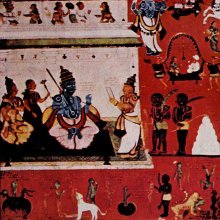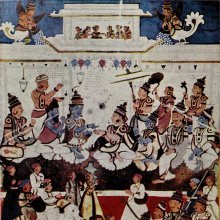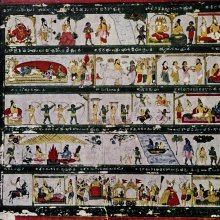Kadapa: 8 definitions
Introduction:
Kadapa means something in Hinduism, Sanskrit, the history of ancient India, Marathi, biology. If you want to know the exact meaning, history, etymology or English translation of this term then check out the descriptions on this page. Add your comment or reference to a book if you want to contribute to this summary article.
Images (photo gallery)
In Hinduism
Shaivism (Shaiva philosophy)
Source: DSpace at Pondicherry: Siddha Cult in Tamilnadu (shaivism)Inscribed Nātha Sculptures of Kadapa, Āndhra Pradesh.—In a small village in Kadapa district of Āndhra Pradesh, an inscription speaks about the donation of land by one Siddhayya after worshipping Sarva Siddhas. The sculptural representations of individual Nāthas appears to be popular in the Āndhra region as evident from the presence of four sculptures of Mañjula-nātha, Megha-nātha, Sāraṅgadhāra and Gorakṣa.

Shaiva (शैव, śaiva) or Shaivism (śaivism) represents a tradition of Hinduism worshiping Shiva as the supreme being. Closely related to Shaktism, Shaiva literature includes a range of scriptures, including Tantras, while the root of this tradition may be traced back to the ancient Vedas.
India history and geography
Source: Wikipedia: India HistoryKadapa (formerly known as Cuddapah) is a city in the Rayalseema region of the south-central part of Andhra Pradesh, India and also called as “Heart of Rayalaseema”. It is the district headquarters of Kadapa district. The city’s name originated from the Telugu word “gadapa” meaning threshold or gate. It acquired this name with its relation to the Tirumala Hills; one had to pass through Cuddapah in olden days to reach Tirumala Hills.
The history of Kadapa dates back to the 2nd century BC. The evidences of Archaeological Survey of India suggest that it started with Mourya and Satavahana dynasty. And since then it has been under the rule of numerous dynasties including Chalukya, Cholas and Pallava.
Source: Knowledge Traditions & Practices of India: Education: Systems & Practices (history)Kadapa or Cuddapah.—In the 1820s, the Collector of Cuddapah (Kadapa in Andhra Pradesh) noted how villagers supported students who came to study under teachers in the vicinity. There were many institutions of higher learning in most districts of Bengal and southern India: the district of Coimbatore alone had over 700 indigenous schools. Significantly, in many districts of south India 78% to 80% of the students in such village schools were from the disadvantaged sections of society.
Source: Shodhganga: Siddha Cult in TamilnaduKadapa refers to one of the various famous Siddha Centre distributed throughout South India and Tamil Nadu. The Siddha cult represents a Tantric philosophy that emerged from the combination of several elements found in traditions such as Shaivism (viz., Pashupata), Shaktism, Jainism, Tantric Buddhism (Vajrayana), etc. Both the Siddha and the Navanath cult (i.e., Nava-natha, ‘nine saints’) are popular in South India [viz., Kadapa] and Tamilnadu. A Siddha was an inspired seer belonging to the marginalized sections of society who dissolved their past karma and crushed the roots of future karma.

The history of India traces the identification of countries, villages, towns and other regions of India, as well as mythology, zoology, royal dynasties, rulers, tribes, local festivities and traditions and regional languages. Ancient India enjoyed religious freedom and encourages the path of Dharma, a concept common to Buddhism, Hinduism, and Jainism.
Biology (plants and animals)
Source: Wisdom Library: Local Names of Plants and DrugsKadapa in the Telugu language is the name of a plant identified with Barringtonia racemosa (L.) Spreng. from the Lecythidaceae (Brazilnut) family having the following synonyms: Eugenia racemosa. For the possible medicinal usage of kadapa, you can check this page for potential sources and references, although be aware that any some or none of the side-effects may not be mentioned here, wether they be harmful or beneficial to health.
Source: Google Books: CRC World Dictionary (Regional names)1) Kadapa in India is the name of a plant defined with Baccaurea courtallensis in various botanical sources. This page contains potential references in Ayurveda, modern medicine, and other folk traditions or local practices It has the synonym Pierardia macrostachya Wight & Arn. (among others).
2) Kadapa is also identified with Barringtonia racemosa It has the synonym Butonica ceylanica Miers (etc.).
Example references for further research on medicinal uses or toxicity (see latin names for full list):
· Hortus Bengalensis (1814)
· Transactions of the Linnean Society of London, Botany (1875)
· Flora de Filipinas (1837)
· Prodromus Systematis Naturalis Regni Vegetabilis (1828)
· Kagoshima University Research Center for the Pacific Islands, Occasional Papers (2001)
· Cell and Chromosome Research (1983)
If you are looking for specific details regarding Kadapa, for example chemical composition, diet and recipes, side effects, extract dosage, pregnancy safety, health benefits, have a look at these references.

This sections includes definitions from the five kingdoms of living things: Animals, Plants, Fungi, Protists and Monera. It will include both the official binomial nomenclature (scientific names usually in Latin) as well as regional spellings and variants.
Languages of India and abroad
Marathi-English dictionary
Source: DDSA: The Molesworth Marathi and English Dictionarykaḍapa (कडप).—n A few handfuls of plants of gram or other of the pulses uprooted and thrown together (into a little heap) to dry previously to the stacking or binding into bundles. The word is in some parts applied to a reap of corn. ka0 vaḷaṇēṃ-basaṇēṃ-hōṇēṃ g. of s. To emaciate or grow lean.
Marathi is an Indo-European language having over 70 million native speakers people in (predominantly) Maharashtra India. Marathi, like many other Indo-Aryan languages, evolved from early forms of Prakrit, which itself is a subset of Sanskrit, one of the most ancient languages of the world.
Kannada-English dictionary
Source: Alar: Kannada-English corpusKaḍapa (ಕಡಪ):—[noun] the art of making forms, sculpturing by chiselling stone, carving wood, modelling clay, casting metal, etc.; sculpture.
Kannada is a Dravidian language (as opposed to the Indo-European language family) mainly spoken in the southwestern region of India.
See also (Relevant definitions)
Starts with: Kadapaiya, Kadapakatti, Kadapam, Kadapananthu, Kadapapa, Kadapapare, Kadapapate, Kadapara, Kadapatya, Kadapavate, Kadapavate-balli, Katapalam, Katapantam, Katapatavenal, Katapayati.
Ends with: Bottakadapa, Rudrakadapa.
Full-text: Cuddapah, Dattamamdala, Kadapya, Khadapa.
Relevant text
Search found 1 books and stories containing Kadapa, Kaḍapa; (plurals include: Kadapas, Kaḍapas). You can also click to the full overview containing English textual excerpts. Below are direct links for the most relevant articles:
Readers’ Mail < [April – June, 2004]
Book Reviews < [October – December, 2000]
Book Reviews < [April – June, 1994]


